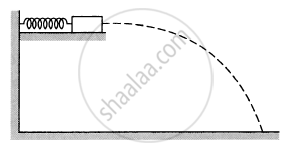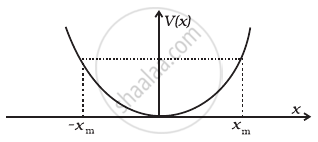Advertisements
Advertisements
Question
An engine is attached to a wagon through a shock absorber of length 1.5 m. The system with a total mass of 50,000 kg is moving with a speed of 36 km h–1 when the brakes are applied to bring it to rest. In the process of the system being brought to rest, the spring of the shock absorber gets compressed by 1.0 m. If 90% of energy of the wagon is lost due to friction, calculate the spring constant.
Solution
Given, mass of the system (m) = 50,000 kg
Speed of the system (v) = 36 km/h
= `(36 xx 1000)/(60 xx 60)` = 10 m/s
Compression of the spring (x) = 1.0 m
KE of the system = `1/2 mv^2`
= `1/2 xx 50000 xx (10)^2`
= 25000 × 100 J
= 2.5 × 106 J
Since 90% of KE of the system is lost due to friction, therefore, the energy transferred to the shock absorber is given by ΔE = `1/2 kx^2`
= 10% of total KE of the system
= `10/100 xx 2.5 xx 10^6 J` or k = `(2 xx 2.5 xx 10^6)/(10 xx (1)^2)`
= 5.0 × 105 N/m
APPEARS IN
RELATED QUESTIONS
When a conservative force does positive work on a body, the potential energy of the body ______.
One end of a light spring of spring constant k is fixed to a wall and the other end is tied to a block placed on a smooth horizontal surface. In a displacement, the work done by the spring is \[\frac{1}{2}k x^2\] . The possible cases are
(a) at spring was initially compressed by a distance x and was finally in its natural length
(b) it was initially stretched by a distance x and and finally was in its natural length
(c) it was initially in its natural length and finally in a compressed position
(d) it was initially in its natural length and finally in a stretched position.
A block of mass m moving at a speed ν compresses a spring through a distance x before its speed is halved. Find the spring constant of the spring.
Consider the situation shown in the following figure. Initially the spring is unstretched when the system is released from rest. Assuming no friction in the pulley, find the maximum elongation of the spring.

A block of mass m sliding on a smooth horizontal surface with a velocity \[\vec{\nu}\] meets a long horizontal spring fixed at one end and with spring constant k, as shown in following figure following. Find the maximum compression of the spring. Will the velocity of the block be the same as \[\vec{\nu}\] when it comes back to the original position shown?

A small block of mass 100 g is pressed against a horizontal spring fixed at one end to compress the spring through 5 cm (figure following). The spring constant is 100 N/m. When released, the block moves horizontally till it leaves the spring. Where will it hit the ground 2 m below the spring?

If a spring extends by x on loading, then energy stored by the spring is (T is the tension in the spring and k is the spring constant)
The potential energy function for a particle executing linear SHM is given by `V(x) = 1/2 kx^2` where k is the force constant of the oscillator (Figure). For k = 0.5 N/m, the graph of V(x) versus x is shown in the figure. A particle of total energy E turns back when it reaches `x = ±x_m`. If V and K indicate the P.E. and K.E., respectively of the particle at `x = +x_m`, then which of the following is correct?

A body is moved along a closed loop. Is the work done in moving the body necessarily zero? If not, state the condition under which work done over a closed path is always zero.
Two identical steel cubes (masses 50 g, side 1 cm) collide head-on face to face with a speed of 10 cm/s each. Find the maximum compression of each. Young’s modulus for steel = Y = 2 × 1011 N/m2.
